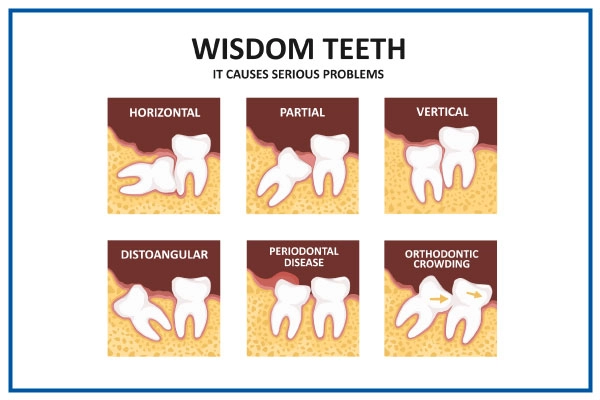Removing Wisdom Teeth: All You Need To Know
Wisdom tooth removal, medically known as third molar extraction, is a commonly performed dental procedure aimed at addressing various dental health issues associated with the emergence of wisdom teeth. These third molars typically appear during the late teenage years or early adulthood, and their presence can often lead to complications due to their size, positioning, and potential for impaction. This comprehensive guide provides a detailed exploration of wisdom tooth removal, encompassing its indications, preparatory steps, the procedure itself, post-operative recovery, lifestyle adjustments, and answers to frequently asked questions.
Indications of Wisdom Tooth Removal:
Wisdom tooth removal is indicated when these molars, located at the back of the mouth, encounter difficulties while emerging or pose potential risks to oral health. Some common indications include:
- Impaction: Wisdom teeth may become impacted, which means they are unable to emerge fully due to lack of space. Impacted teeth can cause pain, infection, and damage to neighboring teeth.
- Misalignment: Wisdom teeth can emerge at awkward angles, leading to misalignment of existing teeth and potential orthodontic issues.
- Pain and Discomfort: Erupting wisdom teeth often cause pain, swelling, and discomfort, necessitating their removal to alleviate these symptoms.
- Cysts and Tumors: In rare cases, cysts or tumors may form around impacted wisdom teeth, potentially causing damage to the jawbone and adjacent teeth.
The purpose of wisdom tooth removal is to prevent these complications, promote oral health, and ensure the overall well-being of the patient.
Who will treat for Wisdom Tooth Removal:
Qualified dental professionals, such as Dentists or oral surgeons, are responsible for performing wisdom tooth removal procedures. In cases where patients experience symptoms or suspect issues with their wisdom teeth, it is recommended to contact their primary dentist initially. The dentist will conduct a thorough evaluation, which may include X-rays, to determine the necessity of the procedure. If the situation calls for it, the dentist might refer the patient to an oral surgeon who specializes in dental surgeries.
Preparing for wisdom tooth removal:
Preparing for a wisdom tooth removal procedure involves several essential steps:
- Consultation: Schedule a consultation with your dentist or oral surgeon. During this visit, the dental professional will examine your mouth, assess the condition of your wisdom teeth, and discuss the best course of action.
- Medical History: Provide a comprehensive medical history, including any allergies, medical conditions, and medications you are currently taking. This information helps the dental team tailor the procedure and anesthesia to your specific needs.
- Anesthesia Options: Discuss anesthesia choices with your dentist or oral surgeon. Depending on the complexity of the procedure and your comfort level, you might opt for local anesthesia, sedation, or general anesthesia.
- Post-Procedure Plans: Arrange for transportation to and from the dental office on the day of the procedure, especially if you're undergoing sedation or general anesthesia. You won't be in a condition to drive after the surgery.
What Happens During wisdom tooth removal:
The wisdom tooth removal procedure involves several key stages:
- Anesthesia Administration: Before the procedure begins, the chosen anesthesia is administered to ensure you remain comfortable and pain-free throughout the surgery. Your dental professional will discuss the anesthesia options and their effects with you beforehand.
- Incision and Access: If the wisdom tooth is impacted, the surgeon makes an incision in the gum tissue to access the tooth. In some cases, a portion of the bone covering the tooth might need to be removed.
- Tooth Extraction: The tooth is carefully extracted using specialized dental instruments. In cases of impacted teeth, the tooth might need to be sectioned into smaller pieces to facilitate removal.
- Stitching: After the tooth is removed, the incision site is sutured to promote proper healing. Some stitches dissolve over time, while others might require removal during a follow-up appointment.
- Gauze Placement: Gauze pads are placed over the extraction site to control bleeding and promote the formation of blood clots.
Recovery after wisdom tooth removal:
After the procedure, the recovery period is crucial for proper healing and minimizing discomfort. Here's what to expect during the recovery phase:
- Immediate Aftercare: You will spend some time in the recovery area under observation before being allowed to go home. This ensures that you are stable and recovering well from the anesthesia.
- Pain Management: It is normal to experience some pain and discomfort after the procedure. Your dental professional will prescribe pain relievers to manage this discomfort. Follow the instructions carefully for the appropriate dosage.
- Swelling and Bruising: Swelling and bruising around the jawline and cheeks are common after wisdom tooth removal. Applying cold packs to the affected area for the first 24 hours can help minimize swelling.
- Dietary Restrictions: Stick to a soft-food diet for the initial days after the surgery. Avoid hard, crunchy, or spicy foods that could irritate the surgical site.
- Oral Hygiene: Maintaining proper oral hygiene is crucial. Your dentist will provide guidelines on how to clean your mouth without disturbing the surgical site. Avoid brushing near the surgical area for the first few days.
- Physical Rest: Engage in limited physical activity for the first few days to allow your body to focus on healing. Avoid strenuous activities that could increase bleeding or discomfort.
Lifestyle Changes After wisdom tooth removal:
As you continue to recover, there are certain lifestyle adjustments to consider:
- Dietary Transition: Gradually reintroduce solid foods into your diet as advised by your dental professional. Begin with soft foods and gradually move to a regular diet as tolerated.
- Oral Hygiene Continuation: Continue to maintain good oral hygiene. As the surgical site heals, you can gently clean the area using a soft-bristle toothbrush.
- Follow-Up Appointments: Attend any follow-up appointments scheduled by your dentist or oral surgeon. These appointments are crucial for monitoring your healing progress and addressing any concerns.

